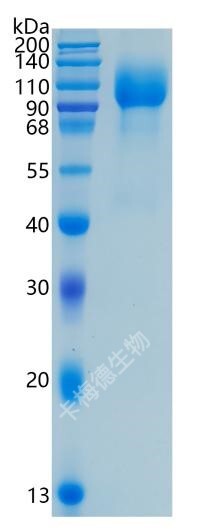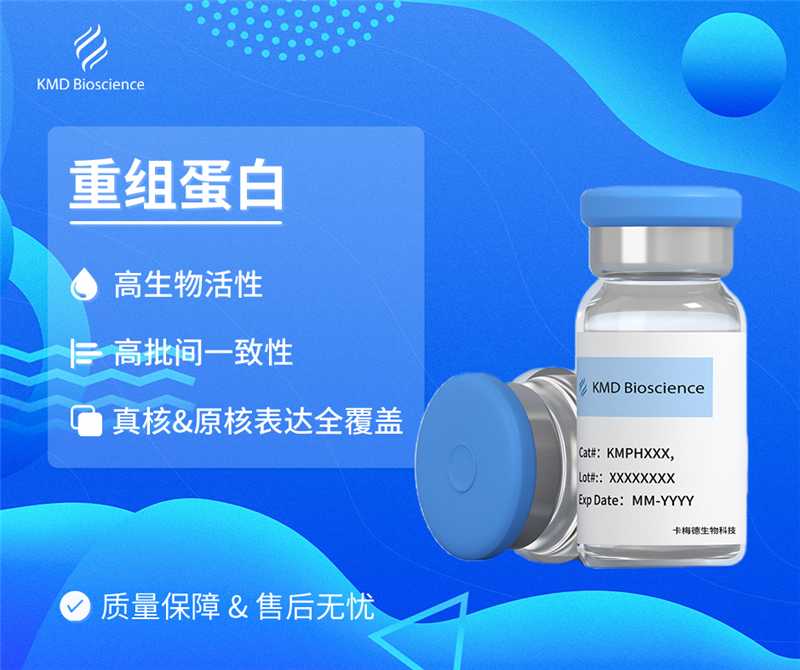| Catalog Number | KRP164 |
| Alias | 成纤维细胞生长因子受体1, Fibroblast growth factor receptor 1 , FGFR-1, EC 2.7.10.1, Basic fibroblast growth factor receptor 1, BFGFR, bFGF-R-1, Fms-like tyrosine kinase 2, FLT-2, N-sam, Proto-oncogene c-Fgr, CD antigen CD331, BFGFR, CEK, FGFBR, FLG, FLT2 |
| Size | 20ug, 50ug, 100ug, 200ug, 1mg |
| Product Description | Human FGFR1(Arg22-Glu376) |
| Molecular Name | FGFR1 |
| Product Introduction | 成纤维细胞生长因子受体1促进成纤维细胞生长的受体,参与伤口修复过程。。 |
| Molecular Weight | 60-70 kDa |
| Expression System | HEK293F Cells |
| Species | Human |
| Concentration | 联系销售经理获得最新批次的浓度 |
| Purity | ≥95% |
| SDS-PAGE |  |
| Purification | Affinity Purification |
| Uniprot ID | P11362-1 |
| Storage Condition | Store the product under sterile conditions after opening at -80℃ for 12 months. Store the lyophilized powder at -20℃. Avoid repeated freeze-thaw cycles. |
| Formulation | Supplied in PBS |
| Shipping Condition | This product is shipped on ice packs or dry ice. |
| Background | Tyrosine-protein kinase that acts as a cell-surface receptor for fibroblast growth factors and plays an essential role in the regulation of embryonic development, cell proliferation, differentiation and migration. Required for normal mesoderm patterning and correct axial organization during embryonic development, normal skeletogenesis and normal development of the gonadotropin-releasing hormone (GnRH) neuronal system. Phosphorylates PLCG1, FRS2, GAB1 and SHB. Ligand binding leads to the activation of several signaling cascades. Activation of PLCG1 leads to the production of the cellular signaling molecules diacylglycerol and inositol 1,4,5-trisphosphate. Phosphorylation of FRS2 triggers recruitment of GRB2, GAB1, PIK3R1 and SOS1, and mediates activation of RAS, MAPK1/ERK2, MAPK3/ERK1 and the MAP kinase signaling pathway, as well as of the AKT1 signaling pathway. Promotes phosphorylation of SHC1, STAT1 and PTPN11/SHP2. In the nucleus, enhances RPS6KA1 and CREB1 activity and contributes to the regulation of transcription. FGFR1 signaling is down-regulated by IL17RD/SEF, and by FGFR1 ubiquitination, internalization and degradation. {ECO:0000250|UniProtKB:P16092, ECO:0000269|PubMed:10830168, ECO:0000269|PubMed:11353842, ECO:0000269|PubMed:12181353, ECO:0000269|PubMed:1379697, ECO:0000269|PubMed:1379698, ECO:0000269|PubMed:15117958, ECO:0000269|PubMed:16597617, ECO:0000269|PubMed:17311277, ECO:0000269|PubMed:17623664, ECO:0000269|PubMed:18480409, ECO:0000269|PubMed:19224897, ECO:0000269|PubMed:19261810, ECO:0000269|PubMed:19665973, ECO:0000269|PubMed:20133753, ECO:0000269|PubMed:20139426, ECO:0000269|PubMed:21765395, ECO:0000269|PubMed:8622701, ECO:0000269|PubMed:8663044}. |
| Endotoxin | < 0.1 EU per ug |
| Biological Activity | Measured by its ability to inhibit FGF1 dependent proliferation of Balb/c-3T3 cells. The ED50 for this effect is typically 0.5-5 ng/mL. |
| Product Declaration | 该产品仅供科研使用,不可直接用于人体或注射。 |













 0
0
